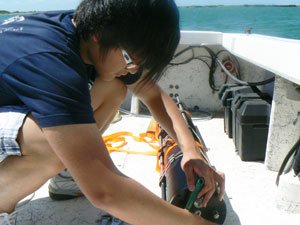CSE team tests submersible camera in Gulf oil spill clean up

A team of College of Science and Engineering researchers has been instrumental in providing a valuable tool used in the cleanup efforts of the catastrophic Gulf of Mexico oil spill.
Jian Sheng, professor of aerospace engineering and mechanics, and three College of Science and Engineering students recently returned from a trip to the Gulf of Mexico where they began testing a high-speed submersible 3D holographic camera, called the HoloSub, to assess the presence of oil slicks below the ocean's surface.
Playing a major role in both the camera design and the future deployment in the Gulf is Yan Ming Tan, a senior majoring in aerospace engineering and mechanics.
Sheng said Ming Tan was crucial in developing the camera, which has the ability to break down the various oil slicks into three-dimensional droplets. By doing so, he said the team is able to better understand the oil spill's impact on the environment.
For Ming Tan, it is an opportunity to apply the knowledge he gained in the classroom to a potentially life-saving cause.
"It has been a highly-rewarding experience," Ming Tan said. "Learning theory is one thing, but when you use it in the field, you find that these equations actually work."
During their initial trip to the Gulf of Mexico, Sheng, Ming Tan and two other students used many of these equations to test the camera, which will be sent down nearly 2,000 meters to learn if oil slicks have a presence underwater like they had on the surface, a possibility being proposed by many scientists involved with the cleanup efforts, Sheng said.
Sheng said the camera was designed specifically for underwater use. With so many research projects never leaving a controlled laboratory, Ming Tan said the opportunity to utilize the camera in the Gulf of Mexico was invaluable.
"I was really excited because Professor Sheng said no one really has access to field projects like this," Ming Tan said. "You can do work in the lab, but it is different when you get actual data from the field."
Sheng said the experience was a revelation for the students, who learned how scientists assess various problems that arise in the real world. In return, the students were able to offer the knowledge they gained in the classroom to the cleanup effort, he said.
"It feels really good to have a hand in this," Ming Tan said. "Whether the underwater oil slicks are there or not, we just want to gain as much knowledge as we can."
Sheng said the camera will be deployed in the upcoming months by using a research vessel run by the National Science Foundation.
